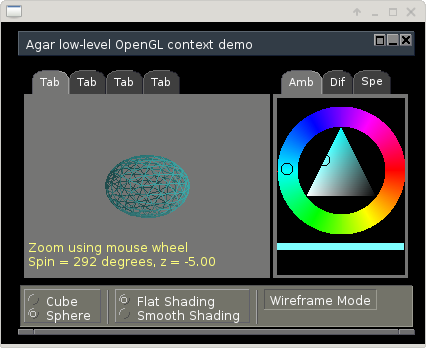SYNOPSIS
#include <agar/core.h> #include <agar/gui.h>
DESCRIPTION
 AG_DriverSw is a subclass of
AG_Driver(3) for "single-window" drivers.
This class of drivers includes dumb framebuffers and any other interface where
Agar needs to implement a window manager internally.
AG_DriverSw is a subclass of
AG_Driver(3) for "single-window" drivers.
This class of drivers includes dumb framebuffers and any other interface where
Agar needs to implement a window manager internally.
INHERITANCE HIERARCHY ↑
AG_Driver(3)-> AG_DriverSw.
INTERNAL API ↑
The
AG_DriverSwClass structure describes a "single-window" graphics driver
(i.e., a dumb framebuffer,
or any other interface where Agar will need to provide its own window manager).
AG_DriverSwClass inherits from
AG_DriverClass and is defined as follows:
At this time, there are no flag options and flags should be initialized to 0.
The openVideo() operation opens a new graphics display of specified dimensions w, h in pixels, and depth in bits per pixel. The flags argument defines the various flags options passed by AG_InitVideo() (see AG_InitVideo(3) for a description of those options).
The openVideoContext() operation "attaches" Agar to an existing display context, passed as ctx. For example, drivers for the SDL library will accept a pointer to a SDL_Surface(3) as ctx. The flags argument specifies video options (see AG_InitVideo(3) for the list of options).
The closeVideo() operation should "close" or detach from a graphics display, releasing any resources previously allocated by openVideo() or openVideoContext().
The videoResize() operation resizes the video display to the specified geometry in pixels. It should return -1 if the display cannot be resized, or 0 on success.
videoCapture() captures the content of the video display to an AG_Surface(3). The function should return 0 on success or -1 on failure.
videoClear() clears the video background with the specified color c.
setVideoContext() changes the existing display context (assumes openVideoContext() has been called before). If the surface size has changed, Agar windows are clamped, moved or resized as appropriate.
typedef struct ag_driver_sw_class {
struct ag_driver_class _inherit;
Uint flags;
int (*openVideo)(void *drv, Uint w, Uint h, int depth,
Uint flags);
int (*openVideoContext)(void *drv, void *ctx, Uint flags);
int (*setVideoContext)(void *drv, void *ctx);
void (*closeVideo)(void *drv);
int (*videoResize)(void *drv, Uint w, Uint h);
int (*videoCapture)(void *drv, AG_Surface **);
void (*videoClear)(void *drv, AG_Color c);
} AG_DriverSwClass;
At this time, there are no flag options and flags should be initialized to 0.
The openVideo() operation opens a new graphics display of specified dimensions w, h in pixels, and depth in bits per pixel. The flags argument defines the various flags options passed by AG_InitVideo() (see AG_InitVideo(3) for a description of those options).
The openVideoContext() operation "attaches" Agar to an existing display context, passed as ctx. For example, drivers for the SDL library will accept a pointer to a SDL_Surface(3) as ctx. The flags argument specifies video options (see AG_InitVideo(3) for the list of options).
The closeVideo() operation should "close" or detach from a graphics display, releasing any resources previously allocated by openVideo() or openVideoContext().
The videoResize() operation resizes the video display to the specified geometry in pixels. It should return -1 if the display cannot be resized, or 0 on success.
videoCapture() captures the content of the video display to an AG_Surface(3). The function should return 0 on success or -1 on failure.
videoClear() clears the video background with the specified color c.
setVideoContext() changes the existing display context (assumes openVideoContext() has been called before). If the surface size has changed, Agar windows are clamped, moved or resized as appropriate.
STRUCTURE DATA ↑
For the
AG_DriverSw (driver instance) object:
| Uint flags | Option flags.
Possible flags include:
| ||||||
| Uint rNom | Nominal display refresh rate in ms. | ||||||
| int rCur | Effective display refresh rate in ms. | ||||||
| Uint winop | Modal window-manager operation in effect, may be set to AG_WINOP_NONE (normal operation), AG_WINOP_MOVE (a window is being moved) or AG_WINOP_[LRH]RESIZE (a window is being resized left/right/horizontally). |
SEE ALSO ↑
HISTORY ↑
The
AG_DriverSw class first appeared in
Agar 1.4.0.

